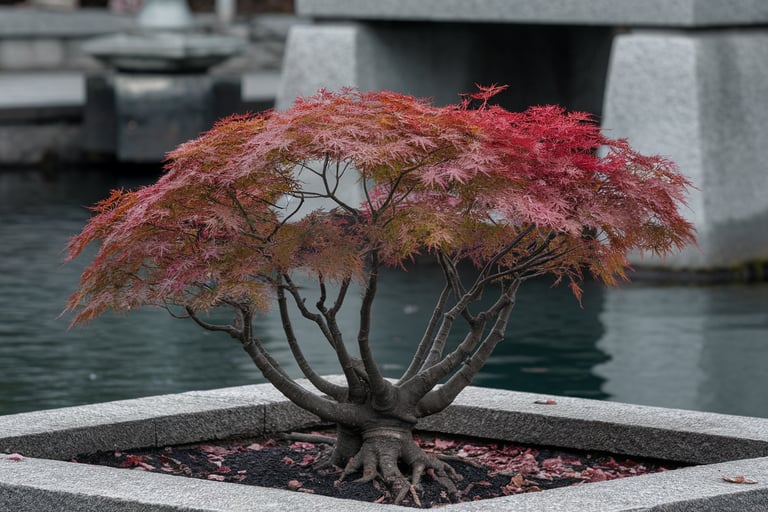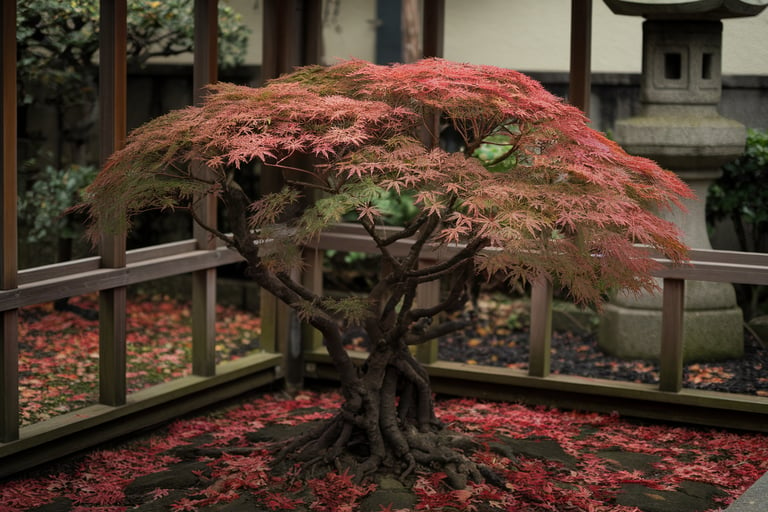
Japanese Maple Care Guide: Expert Tips for Vancouver Gardens
12/18/20246 min read
Growing Japanese Maples (Acer palmatum) in Vancouver's climate can create stunning focal points in any garden. Our mild winters and moderate summers make Vancouver an ideal location for these elegant trees, but proper care specific to our Pacific Northwest conditions is essential for their success.
Understanding Vancouver's Climate Impact
Vancouver's unique climate presents both advantages and challenges for Japanese Maple cultivation. Our moderate temperatures and high rainfall generally suit these trees well, but our occasional extreme weather events require special consideration. The Vancouver weather data from Environment Canada shows our average annual rainfall exceeds 1,200mm, which means proper drainage is crucial for these trees.
Selecting the Right Location
In Vancouver's gardens, Japanese Maples thrive when planted in locations that protect them from our strongest weather patterns. The afternoon sun can be particularly intense during our summer months, especially in areas like Point Grey and Kitsilano where western exposure can be harsh. Choose a spot with filtered sunlight or morning sun with afternoon shade.
Local garden centers like GardenWorks and Art's Nursery offer various Japanese Maple cultivars specifically chosen for success in our climate. When selecting your location, consider these Vancouver-specific factors:
Wind Protection: Our winter storms can be harsh, particularly near the water in areas like West Vancouver and North Vancouver. Plant your Japanese Maple where it's protected from strong winds, perhaps near larger evergreens or structures.
Soil Considerations: Vancouver's naturally acidic soil typically ranges from pH 4.5-6.0, which Japanese Maples tolerate well. However, proper soil amendment is still crucial for optimal growth.
Drainage Requirements: Our wet winters mean excellent drainage is non-negotiable. Many Vancouver gardens, especially in areas like Richmond and parts of East Vancouver, have heavy clay soil that needs amendment for proper drainage.
Planting Your Japanese Maple
The best time to plant Japanese Maples in Vancouver is early spring (March to April) or early fall (September to October). These periods allow roots to establish before our summer dry spells or winter rains. When planting, work with our local soil conditions:
Create a planting hole twice the width of the root ball but no deeper. Vancouver's clay-heavy soil often benefits from adding organic matter like composted bark mulch from local suppliers like Western Turf Farms.
Mix in roughly 30% organic matter with your native soil to improve drainage while maintaining moisture retention. This balance is crucial for Vancouver's weather extremes - from our wet winters to increasingly dry summers.
Essential Spring Care
Spring care in Vancouver requires attention to our unique climate patterns. As temperatures begin to rise in March and April, inspect your Japanese Maple for any winter damage. Our wet winters can sometimes lead to fungal issues, so check for signs of disease early in the season.
Fertilization should be timed with our growing season. Apply a slow-release, balanced fertilizer when leaves begin to emerge, typically in late March or early April in Vancouver. Local experts at UBC Botanical Garden recommend using a fertilizer with an NPK ratio of 4-4-4 or 6-6-6 for optimal results in our soil conditions.
Summer Maintenance in Vancouver's Climate
'
Vancouver's summers have become increasingly warm and dry, presenting new challenges for Japanese Maple care. During our dry spells, particularly from July through August, consistent watering becomes crucial. However, it's important to balance this with our local water restrictions.
Water Management
Following Metro Vancouver's water restrictions, establish a watering schedule that complies with regulations while meeting your tree's needs. Early morning watering (before 7 AM) is ideal, allowing water to penetrate deeply before evaporation occurs. During permitted watering times:
Create a shallow basin around the tree's drip line to prevent runoff, especially important in sloped Vancouver gardens. Apply approximately 2-3 inches of water weekly during dry periods, adjusting based on rainfall. For established trees in areas like West Vancouver or North Vancouver, where rainfall patterns can differ significantly from the city center, monitor soil moisture regularly.
Protection from Summer Stress
Vancouver's summer sun can be intense, particularly in July and August. While our climate is generally moderate, recent heat waves have shown the importance of additional protection. Install temporary shade cloth during extreme heat events, especially for young trees or those with delicate laceleaf varieties.
Mulching for Vancouver Conditions
Our climate's fluctuation between wet winters and dry summers makes proper mulching essential. Apply a 2-3 inch layer of organic mulch, keeping it away from the trunk to prevent rot in our wet conditions. Local arborists recommend using composted bark mulch available from Fraser Valley Bark or similar local suppliers.
Fall Preparation
As Vancouver transitions to fall, typically by mid-September, Japanese Maples require specific care to prepare for our wet season:
Reduce watering gradually as natural rainfall increases. This helps the tree prepare for winter dormancy. Monitor the drainage around your tree, especially crucial in areas like Richmond or False Creek where soil can become waterlogged.
Clean up fallen leaves regularly to prevent fungal issues common in our wet climate. Vancouver's high humidity and rainfall can create perfect conditions for leaf diseases if debris accumulates.
Winter Protection Strategies
While Vancouver's winters are mild compared to much of Canada, they present unique challenges for Japanese Maples. Our wet, heavy snow can damage delicate branches, and occasional arctic outflows can threaten less hardy varieties.
Snow Load Management
When heavy, wet snow is forecast (common in Vancouver's North Shore and higher elevations), gently brush accumulating snow from branches to prevent breakage. For younger or more delicate specimens, consider installing temporary support structures available from local garden centers like Canadian Tire or Home Depot.
Cold Protection
During rare but severe cold snaps, particularly when arctic air moves in through the Fraser Valley, protect your Japanese Maple by:
Creating temporary wind barriers using burlap screens, especially important in exposed gardens. Ensure adequate drainage before winter rains begin, as saturated soil combined with freezing temperatures can damage roots.
Pruning Techniques for Vancouver Gardens
Pruning Japanese Maples in Vancouver requires understanding our unique growing season and climate patterns. The best time for major pruning is during our dormant season, typically late December through February, before the sap begins to flow.
Seasonal Pruning Schedule
Winter Pruning: Focus on structural pruning during dormancy. Remove crossing branches and establish proper form while being mindful of our wet winter conditions. Consult with local certified arborists like Davey Tree Vancouver for major pruning work.
Spring Clean-up: Once leaf buds begin swelling (usually March in Vancouver), remove any winter-damaged branches. This is particularly important after ice storms or heavy snow events.
Summer Maintenance: Light pruning can be done in summer to maintain shape, but avoid heavy pruning during our increasingly hot summer months as it can stress the tree.
Common Vancouver Pest and Disease Issues
Japanese Maples in Vancouver face several region-specific challenges that require monitoring and management:
Aphids and Scale Insects: Our mild climate can allow these pests to thrive. Contact the UBC Plant Care Office for environmentally friendly control methods suited to our region.
Verticillium Wilt: This soil-borne disease is particularly problematic in Vancouver's wet conditions. Ensure proper drainage and avoid planting in areas where the disease has been present.
Powdery Mildew: Our humid summer nights combined with warm days can create perfect conditions for mildew. Improve air circulation and avoid overhead watering.
Troubleshooting Common Issues
Leaf Scorch: Despite Vancouver's moderate climate, leaf scorch can occur in exposed locations, particularly during our increasingly hot summers. Consider installing shade cloth during heat waves and ensure consistent watering during dry spells.
Root Problems: Our heavy winter rains can lead to root issues. Work with local soil testing services like Pacific Soil Analysis to assess drainage and soil composition.
Fertilization and Soil Management
Vancouver's naturally acidic soil typically works well for Japanese Maples, but regular soil maintenance is essential:
Test soil pH every 2-3 years, as local conditions can vary significantly. Areas with recent construction or landscaping may need additional amendments.
Apply organic fertilizers in early spring, following the natural growth cycle of our climate. Local suppliers like West Coast Seeds offer appropriate organic options.
Long-term Care and Maintenance
For established Japanese Maples in Vancouver gardens:
Monitor growth patterns in relation to our changing climate. Recent weather trends show warmer, drier summers and more extreme winter events.
Consider installing a drip irrigation system that complies with Metro Vancouver water restrictions while providing consistent moisture.
Frequently Asked Questions
Q: When is the best time to plant a Japanese Maple in Vancouver?
A: Early spring (March-April) or early fall (September-October) are ideal, allowing roots to establish before extreme weather.
Q: How often should I water my Japanese Maple in Vancouver's summer?
A: During dry spells, water deeply once or twice weekly, following local water restrictions and adjusting based on rainfall.
Q: Do Japanese Maples need protection from Vancouver winters?
A: While generally hardy in our climate, young or delicate varieties may need protection from heavy snow and rare cold snaps.
Q: What's the best location for a Japanese Maple in a Vancouver garden?
A: Choose a spot with morning sun and afternoon shade, protected from strong winds and with excellent drainage.
Ready to add a Japanese Maple to your Vancouver garden? Visit local nurseries like GardenWorks or Art's Nursery to explore varieties specifically suited to our climate. For professional landscape service on placement and care, consider consulting with certified arborists or landscape designers who understand Vancouver's unique growing conditions.
Remember, successful Japanese Maple care in Vancouver requires attention to our specific climate patterns and growing conditions. With proper care and maintenance, these beautiful trees can thrive in your Pacific Northwest garden for generations to come.




Contact
Blossomscaping@gmail.com
+1-604-339-9217
© 2024. All rights reserved.
Where we service
3158 W 34th Ave, Vancouver, BC V6N 2S2
UBC - Cambie - Dunbar - West Vancouver - North Vancouver - West Point Grey - Shaughnessey - Richmond - Kerrisdale - South Vancouver - East Vancouver - Kitsilano - Burnaby - Mount Pleasant - Oakridge - Arbutus Ridge - Marpole - Southlands - Victoria-Fraserview


Proudly Servicing Vancouver, British Columbia
What we service
